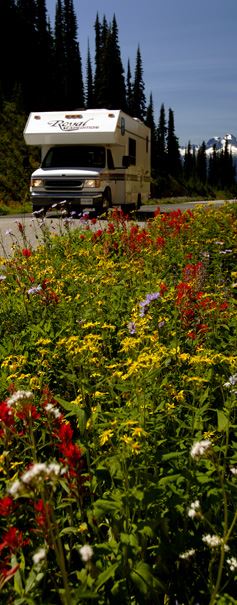|
Highways and roadways
Auto & RV Rental
Rules of the road
Driver's licences and permits
Scenic drives
Driving distances
Whether you rent or drive your own vehicle, Canada's vast network of well-maintained roads and highways will take you anywhere you want to go.
Canada's highway system includes the Trans-Canada Highway, which will take you from coast to coast. The world’s longest national road is a highway system that joins all 10 provinces of Canada, extending 7,821 km.
For information on highway and road conditions by province and territory, visit the Transport Canada website. Visit the Weather Network website for highway road condition updates on most Canadian cities.
Auto rental
Canada has several car rental companies found at airports and in major towns and cities, including Budget, Discount, Hertz, National, Enterprise and Thrifty, among others. Rates vary depending on the season, type of vehicle and length of rental. The minimum age to rent a vehicle ranges from 21-25 years old. Most companies require renters be at least 25 years of age, or may charge additional fees for those under 25. You must also possess a major credit card. Requirements may vary from province to province. Be sure to reserve your car ahead of time during peak travel times, from mid May to summer.
RV rental
Camper and motor home rentals are also widely available. Reserve well ahead of time for the peak summer season. Many provincial and national parks, private campgrounds and other conservation areas in Canada allow you to camp with your RV.
For great advice on RV rental in Canada, visit the Go RVing website. You'll find travel advice and resources including links to RV parks and campgrounds as well as tips to help you enjoy the journey.
Canadian traffic rules are similar to American rules. For example, Canadians drive on the right side of the road. But most safety laws are determined on a provincial and territorial level, so make sure you know the particular rules for the province you will be visiting.
Here are some important tips and safety advice to make your journey to Canada safe and memorable:
- Canadians drive on the right side of the road.
- Seat belts are compulsory.
- Children under five must be in child restraints.
- If your car is not equipped with daytime running lights, drive with your headlights on, especially just prior to sunset and immediately after dawn.
- Right turns on red lights are permitted in most cities across the country after a full stop; however, certain areas of Quebec prohibit such turns. For more information, check with the Government of Quebec's website.
- Traffic signals, such as a flashing green light, do not mean the same thing across all provinces and territories. Check the driving websites of the provinces you plan to visit.
- Radar detection devices are illegal in many Canadian provinces.
- Motorcyclists must wear helmets.
- Pedestrians have the right-of-way and you must yield to pedestrians at crosswalks.
- The speed limit on the auto routes (limited-access highways) is usually 100 km/hr . Speed limits are enforced.
- Drivers must carry proof of insurance in Canada at all times.
- Driver tips for summer road trips can be found at the Canada Safety Council website.
- For practical road safety tips, visit the Transport Canada website.
- You can find a complete rundown of Canadian traffic regulations by consulting the online version of the Motor Vehicle Safety Act.
For a guide to some of Canada's best scenic drives, from the Viking Trail to the Icefields Parkway, visit the scenic drives page
U.S. Visitors – Your American driver's licence is valid in Canada
Make sure you bring along proof of insurance by asking your insurance company for a free "Non-resident Inter-Provincial Motor Vehicle Liability Insurance Card" before you leave, or carry the policy itself. If you're driving a borrowed car or trailer, bring a letter of permission signed by the owner. If you're driving a rented car, carry a copy of the rental contract.
All other visitors to Canada – Applying for the International Driving Permit (IDP)
If you are visiting from outside the United States, you must apply for an International Driving Permit (IDP) from the Automobile Association in your country of residence before you leave. This will allow you to drive in Canada and rent a car here.
The IDP is a special licence for tourists, authorized by UN treaty, which is printed in 10 languages and recognized in over 150 countries around the world.
For a list of driving distances between 18 cities in Canada, visit the Atlas of Canada website. You can convert kilometres to miles here. To see a chart of the driving distances between major Canadian and American cities, click here.
|



 The Official Site of the Canadian Tourism Commission © 2006
The Official Site of the Canadian Tourism Commission © 2006